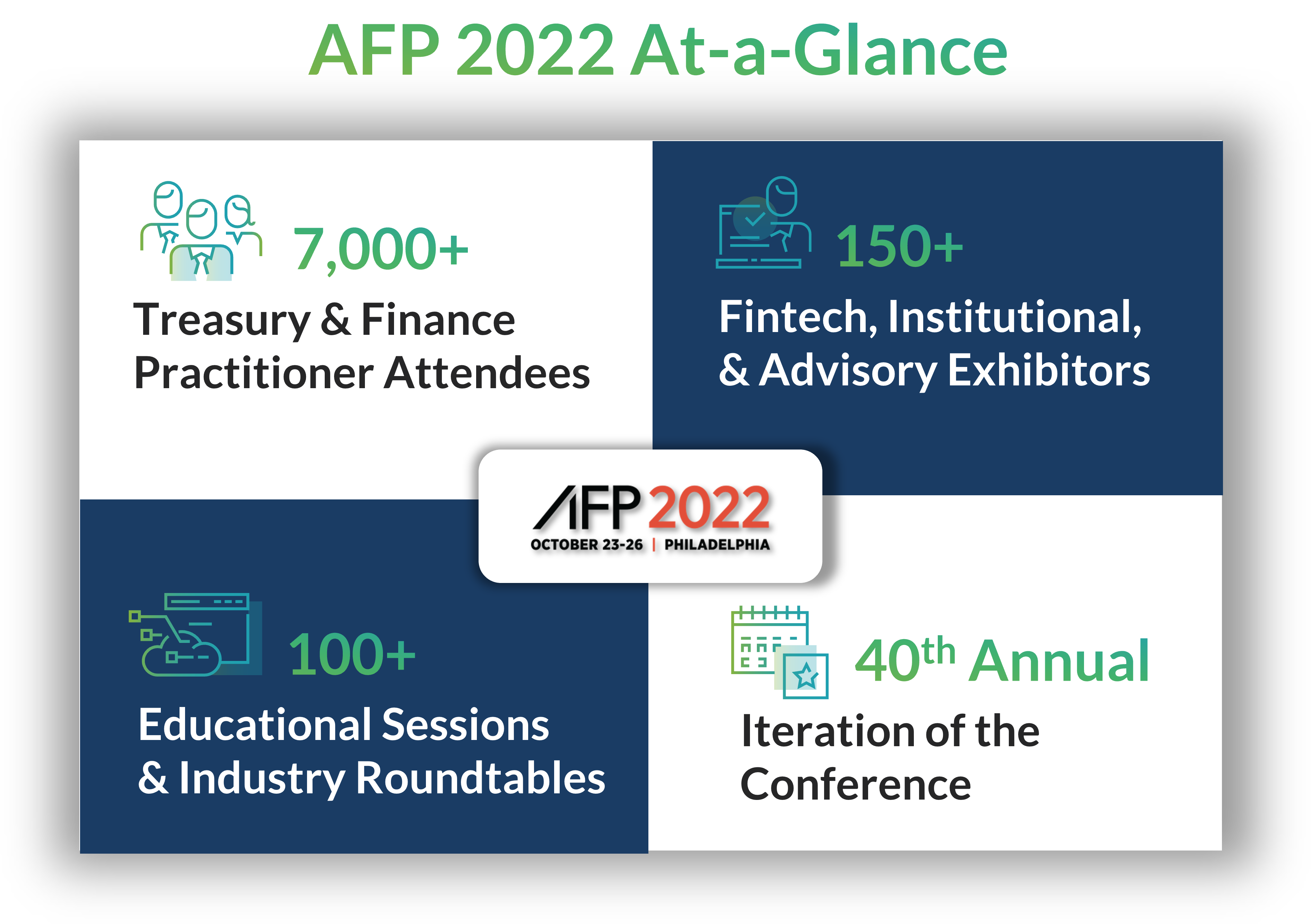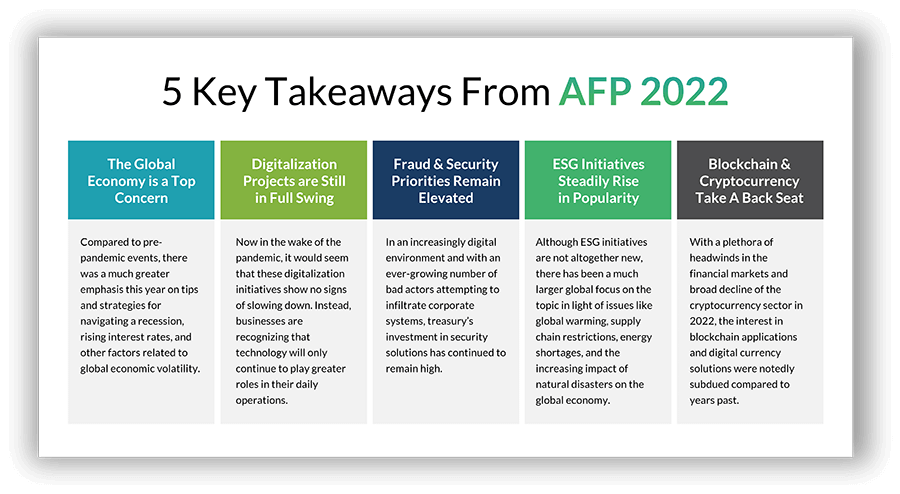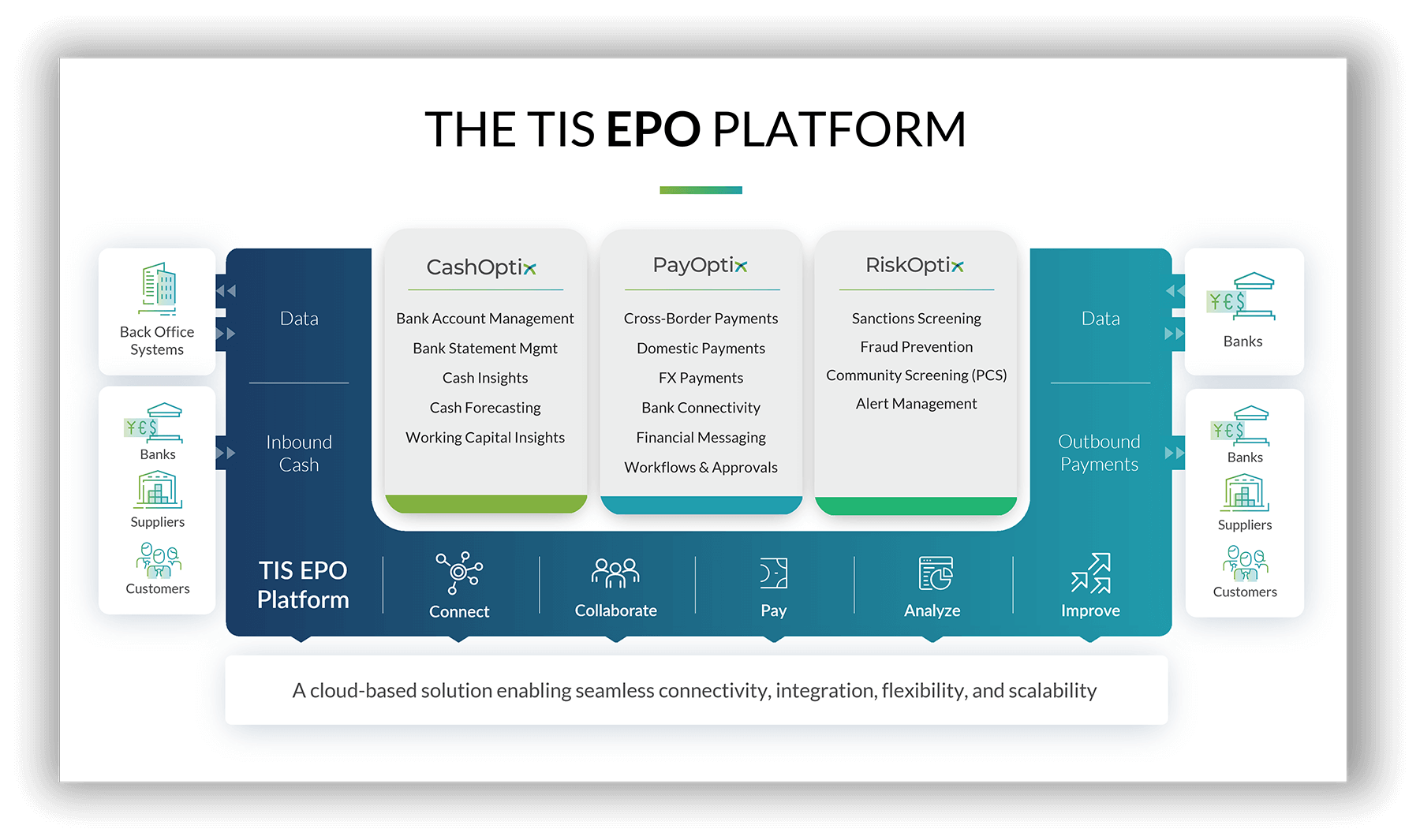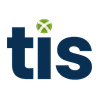This blog provides an overview of the primary themes and talking points from AFP 2022. The insights are based on hundreds of conversations with practitioners in the exhibit hall as well as the key takeaways shared through the 150+ educational sessions, seminars, and workshops that took place during the conference.
Introduction
After several years of virtual and “hybrid” events, AFP 2022 provided the opportunity for many U.S. practitioners to attend their first in-person conference since before the 2020 pandemic.
With 2022 marking the 40th anniversary of AFP, over 7,000 treasury and financial professionals converged with hundreds of Fintech, banking, and financial service providers in Philadelphia for a host of networking, education, and career development opportunities.

As a component of AFP, over 100 industry seminars, roundtables, and workshops were offered to keep practitioners abreast of the latest developments occurring in the finance and banking arena. Based on the insights shared through these sessions and subsequent conversations with hundreds of practitioners over the course of the conference, this blog highlights TIS’ five key AFP takeaways for treasury and finance teams to consider over the course of the next year.
5 Key Takeaways from AFP 2022

1. Economic Volatility is on Everyone’s Mind. Since the last “official” in-person AFP event in 2019, the global economic and geopolitical environments have shifted significantly. As such, it was no surprise to find that many practitioners at this year’s conference had concerns regarding a recession, rising interest rates, FX volatility, and other factors stemming from widespread economic duress.
During discussions with practitioners in the exhibit hall, it was clear that limiting exposure to risk, reducing spend, and maximizing returns on available cash have become critical priorities. This has resulted in a heightened interest in hedging and FX best practices, as well as strategies for optimizing working capital, managing liquidity, and reducing banking and technology costs. And with the current volatility showing few signs of abating, treasury and finance teams will likely continue to prioritize risk mitigation, working capital optimization, and the reduction of their various operational, technological, and banking costs.
2. Digitalization Projects Continue in Full Swing. Even before the pandemic, the “digitalization” of treasury and finance operations was occurring at a rapid pace. But during the past 2-3 years, technology and automation projects have been prioritized with even greater fervor as work-from-home restrictions and remote operations required an even greater reliance on digital solutions.
Now in 2022, technology has become crucial for today’s treasury and finance teams.
Given the traditionally smaller size of treasury teams, the automation of their core payments, cash management, and forecasting processes has become essential for managing daily operations in an efficient fashion. The use of advanced systems for defending against fraud, managing compliance, and performing data analysis functions have also become essential. And with a plethora of cloud-based treasury, banking, and financial platforms available alongside a rapidly-developing suite of “new-age” blockchain and AI solutions, practitioners have a diverse range of options to choose from.
3. Fraud & Security are Still Major Concerns for Treasury. While treasury priorities rise and fall throughout the years, one priority that has stayed top-of-mind for the majority of the industry is the need to prevent and detect financial fraud.
In an increasingly digital environment and with an ever-growing number of bad actors using advanced technology to probe and infiltrate corporate systems, treasury’s interest and investment in security solutions has remained elevated in 2022.
Although the topic of security is not new for treasury, the continued emphasis by practitioners to ensure complete protection of their systems and workflows was evident at this year’s conference. There were dozens of roundtables and seminars analyzing the most recent cases of fraud, as well as in-depth analysis of the best practices available for defending against them. All of these sessions were well-attended.
Overall, this year’s event highlighted that there is no single “greatest threat” that companies must watch out for, but rather, they must continue to defend against a broad variety of illicit activity being perpetrated from both internal and external sources. And as today’s nefarious actors become even more tech-savvy and subversive with their attempts, so practitioners must become more adept at shoring up their firms’ vulnerabilities to cyber-attacks in all forms.
4. ESG Initiatives Continue Gaining Momentum: One of the newer items arriving on treasury’s purview is that of ESG, or “Environmental, Social, & Corporate Governance”. At a high level, ESG initiatives are intended to drive more sustainable business practices by rewarding or requiring investments in eco-friendly or socially responsible operations. Concurrently, various national agencies and global regulatory bodies have attempted to garner more support for ESG policies by offering incentives, such as tax breaks for the use of solar energy.
Although ESG initiatives are not altogether new, there has been a much larger global focus on the topic in light of issues like global warming, supply chain restrictions, energy shortages, and issues related to social justice (e.g., executive and board-member positions available for women and minorities). Geopolitical turmoil and the resulting influx of new compliance and regulatory restrictions has also impacted ESG, as businesses must be more wary of who their suppliers and vendors are and what types of practices they promote. In the years ahead, ESG initiatives will undoubtedly play a greater role in treasury operations, and practitioners must begin preparing for their adoption sooner rather than later.
5. Blockchain & Cryptocurrency See Reduced Emphasis. With numerous headwinds in the financial markets and the broad decline of cryptocurrency payment and investment volumes in 2022, the interest in blockchain applications and digital currency solutions at AFP were notably subdued compared to years past. With only a small number of blockchain vendors exhibiting and a few scattered educational sessions on the use of crypto within corporate treasury, it would seem that corporate adoption plans have lost momentum in the face of broader economic uncertainty.
While this drop in momentum may ultimately be short-lived, it’s still a sign of shifting priorities for treasury as many companies adopt a more conservative approach to investing in new technologies and innovations until the economic outlook improves.
Final Thoughts
Although just a few years had passed since the last “fully in-person” AFP conference was held, this year’s event demonstrated that even within a period of 2-3 years, the industry’s outlook and list of priorities can change quite rapidly. This was evident when analyzing growing fears about the economy and global recession, as well as the decrease in focus on blockchain and cryptocurrency. However, it also highlighted that some items, such as fraud prevention and ongoing digitalization, remain priorities for finance and treasury practitioners.
In summary, it appears that the overarching focus for treasury and finance teams heading into 2023 will revolve around digitalization, security, and sustainability. And until the global economy can find steadier ground, other objectives such as risk management, cost rationalization, and working capital optimization will be popular as well.
For practitioners looking to address these items, we at TIS encourage you to explore how our cloud-based suite of payments, liquidity, security and compliance solutions can help. With over a decade of experience helping companies automate payments and banking processes, better manage cash and working capital, and protect against fraud and compliance exposures, we offer the perfect solution for companies simultaneously looking to digitalize their processes while also ensuring adequate coverage in the areas that practitioners care most about.

For more information about how TIS can help you automate and simplify your treasury, payments, and banking operations, download our solution guide or contact one of our experts. We hope to hear from you soon!



